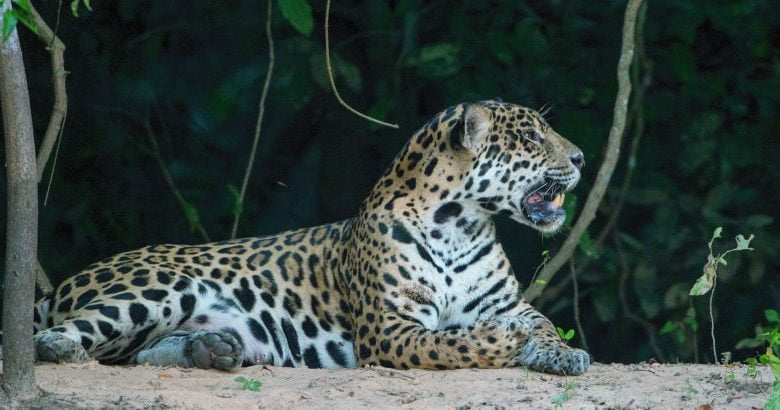Characteristics of the Jaguars

The jaguar is a compact and well-muscled animal. It is the largest cat native to the Americas and the third largest in the world, exceeded in size only by the tiger and the lion.[9][27][28] Its coat ranges from pale yellow to tan or reddish-yellow while the ventral areas are whitish. The fur is covered with spots which develop into rosettes on the sides.
The spots and their shapes vary: rosettes may include one or several dots. The spots on the head and neck are generally solid, as are those on the tail, where they may merge to form a band.[9] These patterns serve as camouflage in areas with dense vegetation and patchy shadows.[29] Jaguars living in forests are often darker and considerably smaller than those living in open areas, possibly due to the smaller numbers of large, herbivorous prey in forest areas.[30]
While the jaguar closely resembles the leopard, it is generally more robust, with stockier limbs and a squarer head. The rosettes on a jaguar’s coat are larger, darker, fewer in number and have thicker lines with a small spot in the middle.[31]
It has powerful jaws with the third-highest bite force of all felids, after the tiger and the lion.[32] It has an average bite force at the canine tip of 887.0 Newton and a bite force quotient at the canine tip of 118.6.[33] A 100 kg (220 lb) jaguar can bite with a force of 4.939 kilonewtons (1,110 pounds-force) with the canine teeth and 6.922 kN (1,556 lbf) at the carnassial notch.[34]
The jaguar stands 68 to 75 cm (27 to 29 1⁄2 in) tall at the shoulders.[35] Its size and weight vary considerably: weights are normally in the range of 56–96 kg (123–212 lb). Exceptionally big males have been recorded to weigh as much as 158 kg (348 lb).[36][37] The smallest females weigh about 36 kg (79 lb).[36] It is sexually dimorphic with females typically 10–20% smaller than males. The length, from the nose to the base of the tail, varies from 1.12 to 1.85 m (3 ft 8 in to 6 ft 1 in). The tail is the shortest of any big cat, at 45 to 75 cm (18 to 30 in) in length.[36][38] Its muscular legs are shorter than the legs of other Panthera species with a similar body weight.[31]
Further variations in size have been observed across regions and habitats, with size tending to increase from north to south. Jaguars in the Chamela-Cuixmala Biosphere Reserve on the Pacific coast of central Mexico weighed around 50 kg (110 lb), about the size of a female cougar.[39] Jaguars in Venezuela and Brazil are much larger with average weights of about 95 kg (209 lb) in males and of about 56–78 kg (123–172 lb) in females.[9]
